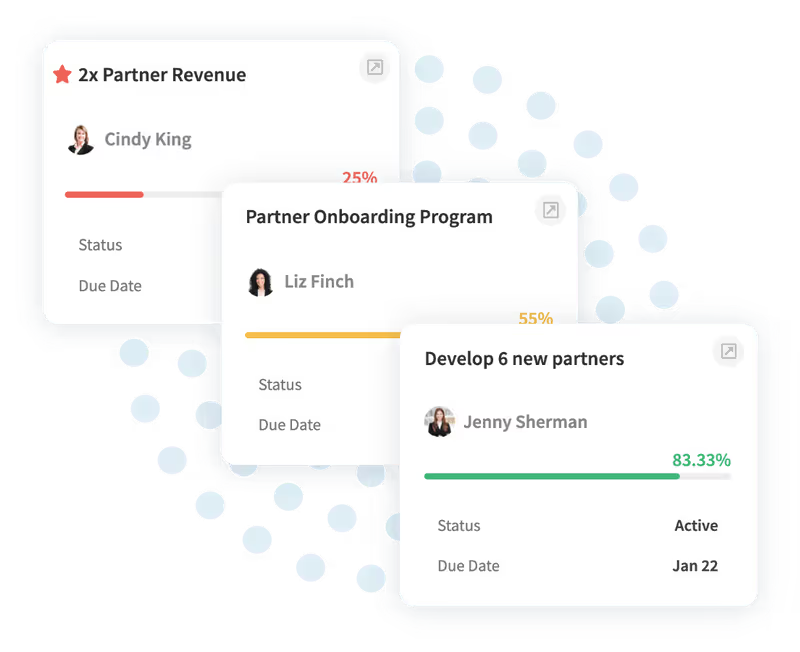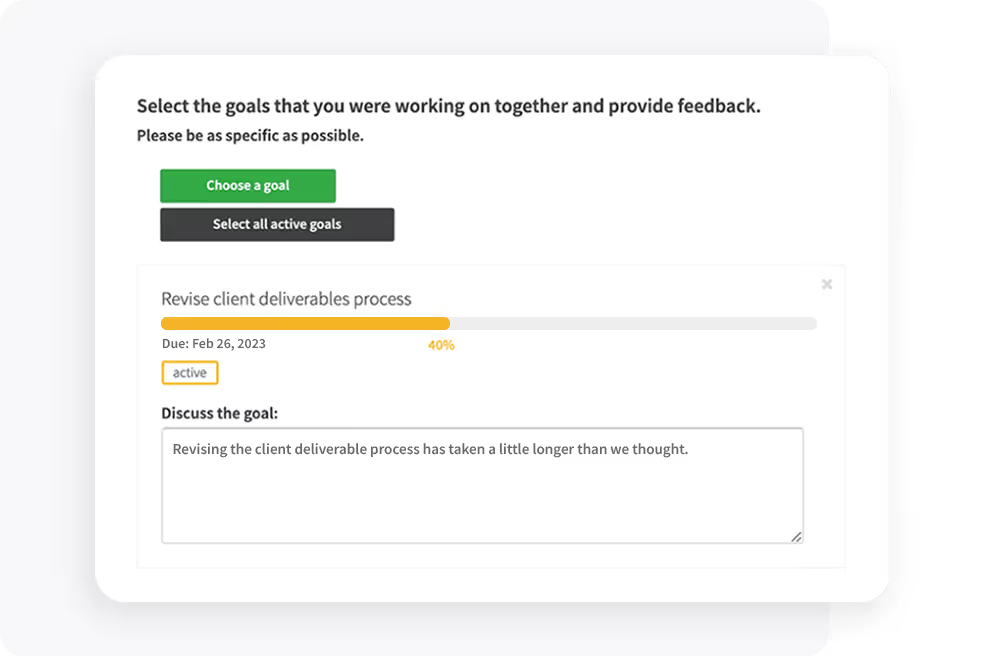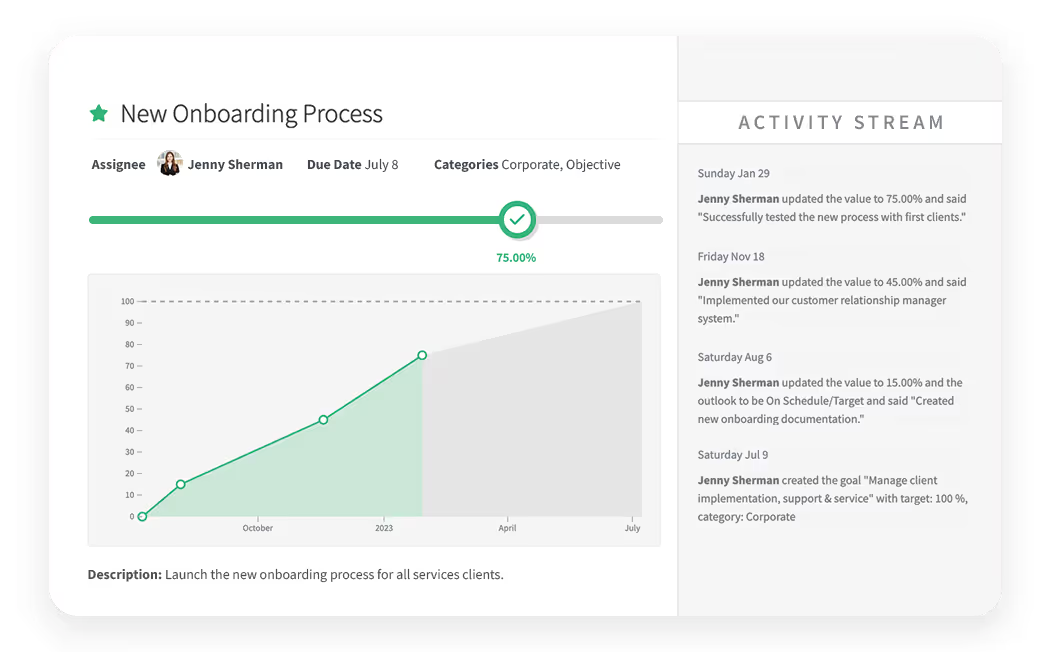14 SMART Leadership Goals by Role & Scenario
Ever feel like leadership is just an endless game of whack-a-mole? One problem pops up, you handle it …, and then three more take its place.
The best leaders don’t just react; they set crystal-clear goals that drive real results. That’s where the SMART framework – Specific, Measurable, Achievable, Relevant, and Time-bound – comes in.
But here’s the catch: leadership isn’t one-size-fits-all.
A CEO scaling a company to new heights needs a different approach than a team lead rallying their employees. A startup founder faces different challenges than a manager transitioning from an individual contributor role.
That’s why we’ve put together these SMART goals for leaders. This will help you set achievable goals for your role, tackle common leadership challenges, and navigate real-world scenarios with clarity and confidence.
Let’s dive in.
SMART Leadership Goals by Role
Not all leaders play the same game, so why set the same goals?
A CEO scaling a company has different priorities than a team lead managing day-to-day operations. SMART goals only work when they fit your role.
Here’s how to set leadership goals that actually move the needle:
SMART Goals for C-Suite Executives (CEOs, CFOs, COOs)
1. Make decisions using data and insights
Gut feelings don’t usually scale a business. C-suite execs need data-driven decisions to cut through the noise, spot real opportunities, and drive predictable, profitable growth.
S-Specific: Use data analytics to make more informed strategic decisions and reduce reliance on guesswork.
M-Measurable: Track and analyze three key business metrics monthly to guide decision-making and measure progress.
A–Achievable: This goal is attainable with the right tools, training, and commitment to regularly reviewing data insights.
R–Relevant: Data-driven decision-making leads to better business outcomes, minimizes risk, and improves overall leadership effectiveness.
T–Time-bound: Implement this goal-setting practice consistently over the next six months and assess its impact on key decisions.
Put it all together: I will use data-driven insights to make strategic decisions over the next six months, tracking key business metrics monthly to minimize risk, identify growth opportunities, and drive predictable, profitable success.
2. Foster a culture of innovation and continuous improvement
Success isn’t just about what works today – it’s about staying ahead of what’s next. Top C-level leaders who prioritize innovation and continuous improvement don’t just react to change. They drive it. Instead of waiting for disruption, they create a culture where new ideas are welcomed and experimentation is encouraged.
S-Specific: Create a positive work environment where employees feel empowered to share ideas, experiment, and improve processes without fear of failure.
M-Measurable: Implement at least one new process, product enhancement, or efficiency improvement per quarter based on employee input and innovation initiatives.
A–Achievable: Establish open communication channels, recognize innovative contributions, and dedicate resources to continuous learning.
R–Relevant: A culture of innovation drives business growth and keeps the company competitive in an ever-changing market.
T–Time-bound: Establish structured innovation and continuous improvement initiatives within the next six months and track their impact on business performance.
Put it all together: I will foster a culture of innovation and continuous improvement over the next six months by encouraging employee-driven ideas, implementing at least one process or product improvement per quarter, and creating an environment where continuous learning and strategic thinking thrive.
3. Increase the team’s productivity through structured performance reviews
A high-performing team doesn’t happen by accident. It happens through clear expectations, regular feedback, and continuous improvement. Mid-level managers who implement structured performance reviews create a culture of accountability and growth. This helps their teams stay focused, motivated, and aligned with business goals.
S-Specific: Implement a structured performance review process that provides employees with constructive feedback, identifies strengths, and outlines areas for growth.
M-Measurable: Conduct formal performance reviews every quarter and track individual and team productivity improvements based on feedback and goal alignment.
A–Achievable: This goal is attainable by setting clear performance metrics, training managers on effective feedback delivery, and using performance management software.
R–Relevant: Regular employee performance reviews drive engagement, increase productivity, and ensure employees are aligned with the company’s strategic objectives.
T–Time-bound: Establish and execute a structured review process within a three-month timeframe, measuring its impact on team performance.
Put it all together: I will implement a structured performance review process within the next three months, conducting quarterly evaluations to provide clear feedback, track team productivity, and ensure alignment with broader organizational objectives.

4. Develop stronger cross-departmental collaboration strategies
When departments don’t communicate, projects stall, misalignment grows, and opportunities slip through the cracks. Mid-level managers play a crucial role in breaking down these barriers by fostering collaboration between teams. They help build smoother workflows and improve overall business performance.
S-Specific: Establish regular cross-departmental meetings and initiatives to improve communication, share knowledge, and facilitate project completion.
M-Measurable: Increase the number of successful cross-functional projects by at least 25% over the next six months, measured by efficiency, timelines, and outcomes.
A–Achievable: Implement collaboration tools, set specific objectives, and encourage team leads to participate in cross-departmental efforts.
R–Relevant: Stronger collaboration leads to improved efficiency, better problem-solving, and more innovative solutions across the organization.
T–Time-bound: Develop and implement a cross-departmental collaboration strategy within the next six months. Track its effectiveness through project success and team feedback.
Put it all together: I will develop a cross-departmental collaboration strategy within the next six months, increasing successful joint projects by 25% and ensuring better communication, efficiency, and alignment across teams.
SMART Goals for Team Leads
5. Enhance team communication and meeting efficiency
Meetings should drive progress, not waste time. Poor communication leads to misunderstandings, delays, and disengagement. Team leads who prioritize clear, efficient communication create stronger alignment, reduce wasted time, and keep their teams focused on what really matters.
S-Specific: Implement structured meeting agendas, clear communication protocols, and streamlined messaging to improve team collaboration and efficiency.
M-Measurable: Reduce average meeting time by 25% within three months while maintaining or improving team alignment and productivity.
A–Achievable: This goal is attainable by using time-saving tools, setting clear agendas, and training team members on concise and effective communication.
R–Relevant: Better communication leads to increased efficiency, fewer misunderstandings, and a more engaged and productive team.
T–Time-bound: Implement these changes within the next three months and assess their impact through team feedback and meeting effectiveness metrics.
Put it all together: I will improve team communication and meeting efficiency over the next three months by implementing structured agendas, reducing meeting time by 25%, and ensuring clear, effective collaboration.
6. Improve employee development through mentorship initiatives
A team is only as strong as its people. When employees grow, the entire organization benefits. Strong mentorship programs help team members build new skills, gain confidence, and feel supported in their professional development. As a team lead, fostering mentorship can drive engagement and support long-term goals.
S-Specific: Establish a mentorship program where experienced team members provide guidance and support to junior employees, helping them develop hard and soft skills.
M-Measurable: Pair at least five mentor-mentee teams within the next six months and track progress through feedback and performance improvements.
A–Achievable: This goal is attainable by setting leadership and mentorship expectations, providing resources, and encouraging participation through recognition and incentives.
R–Relevant: Investing in employees’ professional growth leads to higher retention, stronger engagement, and a more skilled workforce.
T–Time-bound: Launch the mentorship program within the next six months and measure its success through participation rates and mentee progress.
Put it all together: I will establish a mentorship program within the next six months, pairing at least five mentor-mentee teams and tracking their growth to foster employee development and long-term success.
SMART Goals for Emerging Leaders
7. Strengthen decision-making skills through leadership training
Going from “doing the work” to leading the team is a whole new ballgame. New managers often struggle with delegation, communication, and setting expectations. The best way to avoid common pitfalls? Get the right training, apply what you learn, and build leadership habits from day one.
S-Specific: Enroll in a leadership training program focused on management fundamentals, team building, and communication.
M-Measurable: Complete at least one leadership course and implement three new management strategies within 90 days.
A–Achievable: Dedicate time to training, apply best practices, and seek mentorship.
R–Relevant: Strong management skills lead to better team performance, increased trust, and smoother transitions into leadership roles.
T–Time-bound: Enroll in training within the first 30 days and complete the course within 90 days.
Put it all together: I will complete a leadership training program within 90 days, applying three new management strategies to improve communication, delegation, and team alignment.
8. Build confidence in leading team projects
Confidence isn’t just about feeling capable, it’s about taking action. Emerging leaders often struggle with stepping up, making tough calls, and guiding a team to success. The key? Gaining experience, setting clear goals, and learning from every challenge along the way.
S-Specific: Take ownership of a team project from start to finish, leading meetings, delegating tasks, and ensuring project goals are met.
M-Measurable: Successfully manage at least one project within the next six months, tracking progress through deadlines met, team feedback, and project outcomes.
A–Achievable: This goal is attainable by seeking guidance from mentors, using project management tools, and actively improving leadership communication.
R–Relevant: Leading projects builds essential leadership skills, boosts confidence, and prepares emerging leaders for greater responsibilities.
T–Time-bound: Start leading a project within the next three months and complete it within six months, evaluating performance and growth afterward.
Put it all together: I will lead a team project from start to finish within the next six months, ensuring successful completion while improving leadership confidence, delegation, communication skills, and project management abilities.
SMART Goals for Leadership Scenarios
Leadership isn’t just about keeping things running. It’s about tackling problems head-on.
Disengaged teams, poor delegation, constant change… sound familiar? Good leaders don’t just hope things get better; they set SMART goals to fix them.
Here’s how to break through leadership challenges with clear, actionable goals that actually work:
Overcoming Team Disengagement
9. Increase employee engagement scores by 15% within 6 months
A disengaged team is a leader’s worst nightmare. When employees check out, productivity tanks, turnover spikes, and the workplace vibe takes a nosedive. The fix is a clear, intentional plan to boost engagement and make employees feel valued, motivated, and invested in their work.
S-Specific: Implement strategies to improve employee engagement, including regular check-ins, recognition programs, and opportunities for growth.
M-Measurable: Increase employee engagement scores by 15% within six months, tracked through surveys and feedback.
A–Achievable: This goal is attainable by consistently gathering employee input, acting on feedback, and fostering a culture of recognition and development.
R–Relevant: High engagement leads to better retention, stronger performance, and a more motivated workforce.
T–Time-bound: Launch engagement initiatives within the next 30 days and track improvements over six months.
Put it all together: I will increase employee engagement scores by 15% within six months by implementing recognition programs, regular check-ins, and career development opportunities.

Improving Delegation Skills
10. Assign and track 30% more tasks to team members by the next quarter
Trying to do everything yourself? That’s a fast track to burnout. Strong leaders know delegation isn’t about offloading work – it’s about trusting your team, maximizing efficiency, and focusing on high-impact decisions. The key is setting clear expectations, tracking progress, and letting go of the “I’ll just do it myself” mindset.
S-Specific: Improve delegation by assigning more tasks, providing clear instructions, and tracking accountability.
M-Measurable: Increase delegated tasks by 30% within the next quarter, measured through task management tools and completion rates.
A–Achievable: This goal is attainable by identifying key responsibilities to delegate, using productivity tools, and providing necessary support.
R–Relevant: Effective delegation improves efficiency, empowers employees, and allows leaders to focus on high-level priorities.
T–Time-bound: Implement this strategy immediately and track progress over the next three months.
Put it all together: I will improve delegation by assigning and tracking 30% more tasks within the next quarter, ensuring clear instructions, accountability, and better time management.
Leading Through Organizational Change
11. Develop and implement a transparent communication plan during transitions
Change can either unite a team or create chaos. It all depends on how leaders handle it. Uncertainty fuels anxiety, but transparency builds trust. A clear communication plan during transitions keeps employees informed, engaged, and aligned. Pairing this with measurable goals makes even the toughest changes smoother and more successful.
S-Specific: Create a transparent communication strategy that keeps employees informed and engaged during organizational changes.
M-Measurable: Deliver updates on changes at least biweekly and track employee sentiment through pulse surveys.
A–Achievable: Use structured messaging, leadership involvement, and open forums for employee questions.
R–Relevant: Clear communication during transitions reduces uncertainty, builds trust, and keeps teams aligned.
T–Time-bound: Develop and implement the plan within the next 60 days and assess its effectiveness over the next six months.
Put it all together: I will develop and implement a transparent communication plan within the next 60 days, providing biweekly updates and tracking employee sentiment to ensure a smooth transition.
Taking Over a Struggling Team
12. Conduct one-on-one check-ins with each team member within the first 30 days
If you’re walking into a struggling team, the first step to turn things around is active listening. One-on-one check-ins help you assess the issues, build trust, and create a game plan to get the team back on track.
S-Specific: Meet individually with each team member to understand challenges, expectations, and areas for improvement.
M-Measurable: Conduct at least one check-in with every team member within the first 30 days and document key takeaways.
A–Achievable: This goal is attainable by setting a schedule, actively listening, and taking action based on feedback.
R–Relevant: Understanding employee concerns early helps rebuild trust, align goals, and improve overall team performance.
T–Time-bound: Complete all check-ins within the first 30 days and create an action plan based on findings.
Put it all together: I will conduct one-on-one check-ins with each team member within the first 30 days to understand challenges, rebuild trust, and create a plan to improve team performance.

Leading a Fast-Growing Startup
13. Establish scalable team structures and SOPs to manage rapid growth
Startups move fast. One day you’re a small team, the next you’re hiring at lightning speed. Without the right structures in place, growth turns into chaos. The key is scalable team structures and standard operating procedures (SOPs) that keep things running smoothly, no matter how fast the company expands.
S-Specific: Develop clear, specific goals for team structures, roles, and SOPs to streamline operations and manage rapid growth.
M-Measurable: Implement at least three SOPs and define clear team roles within six months.
A–Achievable: This goal is attainable by assessing current workflows, defining key processes, and documenting best practices.
R–Relevant: Scalable systems prevent operational bottlenecks, reduce confusion, and ensure sustainable growth.
T–Time-bound: Establish team structures and implement SOPs within six months to support company expansion.
Put it all together: I will establish scalable team structures and implement at least three SOPs within six months to ensure smooth operations and manage rapid startup growth.
Driving Cultural Change as a CEO
14. Define and reinforce company values through leadership-led initiatives
Culture can make or break your company. If culture is weak, everything else falls apart. As CEO, you set the tone. Defining and reinforcing company values through leadership-led initiatives ensures that your organization stays aligned, engaged, and built for long-term success.
S-Specific: Clearly define company values and implement leadership-driven initiatives that reinforce them.
M-Measurable: Launch at least three company-wide initiatives in the next six months or next year that align with core values.
A–Achievable: This goal is attainable by incorporating values into company meetings, recognition programs, and leadership decisions.
R–Relevant: A strong company culture improves employee engagement, retention, and overall business success.
T–Time-bound: Establish and begin reinforcing company values through leadership-led initiatives within six months.
Put it all together: I will define and reinforce company values through leadership-led initiatives within six months, launching at least three programs that align with our core mission and drive a stronger company culture.
Conclusion
Hopefully, you’re now aware that SMART leadership goals aren’t just checkboxes, they’re the blueprint for real impact. The best team leaders tailor their goals to fit their role, challenges, and unique leadership style.
Now it’s your turn. Pick one SMART goal from above, implement it, and track your progress.
Small, intentional steps today create powerful leadership results tomorrow.



.jpg)

